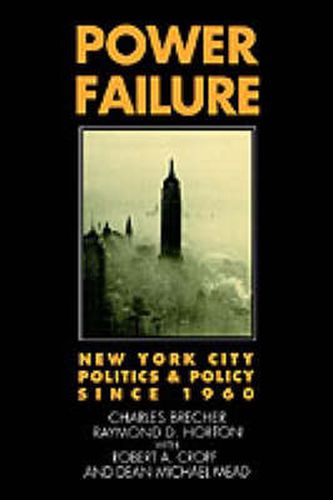Power Failure: New York City Politics and Policy since 1960
Charles Brecher (Associate Professor, Graduate School of Public Administration),Raymond D. Horton (Professor, Graduate School of Business, Professor, Graduate School of Business, both at Columbia University)

Power Failure: New York City Politics and Policy since 1960
Charles Brecher (Associate Professor, Graduate School of Public Administration),Raymond D. Horton (Professor, Graduate School of Business, Professor, Graduate School of Business, both at Columbia University)
New York City’s municipal government is the largest and most complex in the nation, perhaps in the world. Its annual operating budget is now a staggering $29 billion a year, plus it has a capital budget of $4 billion more. The city and its various agencies employ approximately 360,000 full-time workers. The Office of the Mayor alone employs some 1,600 people (and spends some $135 million). And the Police Department boasts a small army of over 25,000 officers, with a budget of $1.5 billion. Anyone wanting to make sense of an organization this vast needs an excellent guide.
In Power Failure, Charles Brecher and Raymond Horton provide a complete guidebook to the political workings of New York City. Ranging from 1960 to the present, the authors explore in depth the political machinery behind City Hall, from electoral politics to budgetary policy to the delivery of city services. They examine the operation of the Office of the Mayor and the City Council, covering everything from the number of members and their annual salaries (Council Members receive $55,000 per year, the Council President $105,000) to the mayoral races of John V. Lindsay, Abraham Beame, and Edward I. Koch. Much of this encyclopedic work focuses on New York’s ever-present financial woes, including the financial crisis of the mid-1970s, when the City had an unaudited deficit of over a billion dollars and the public credit markets closed their doors. They examine the repeated failure of collective bargaining to set wage policy before the annual operating budget is set (which undermines the integrity of the budgetary process), and they look at the main source of revenue, the property tax (homeowners pay 84 cents per hundred dollars of market value, commercial property owners pay $4.31, a politically motivated imbalance which the authors find economically harmful and grossly unfair to renters and businesses). Finally, they examine service delivery and discover, not surprisingly, that the highest local taxes in the nation are not spent efficiently. The authors offer detailed looks at the uniformed services (police, fire, sanitation, corrections), the Department of Parks and Recreation, and the Health and Hospitals Corporation (which operates the country’s largest municipal hospital system), revealing which departments are run well and which are not.
For New York City residents, this is an essential volume for understanding City Hall. Indeed, anyone baffled by big city government–whether you live in New York or in any major metropolis–will find in this volume a wealth of information on how to run a city well, and how to run it into the ground.
This item is not currently in-stock. It can be ordered online and is expected to ship in approx 2 weeks
Our stock data is updated periodically, and availability may change throughout the day for in-demand items. Please call the relevant shop for the most current stock information. Prices are subject to change without notice.
Sign in or become a Readings Member to add this title to a wishlist.

